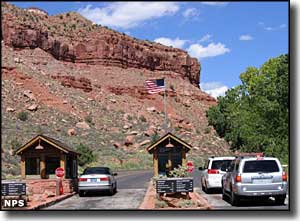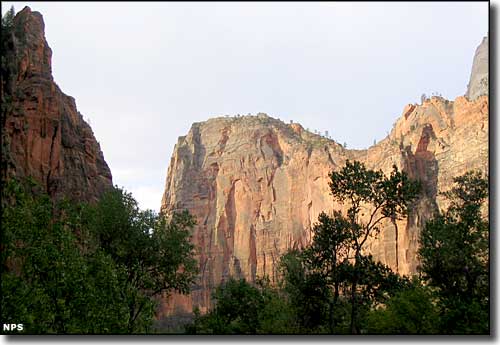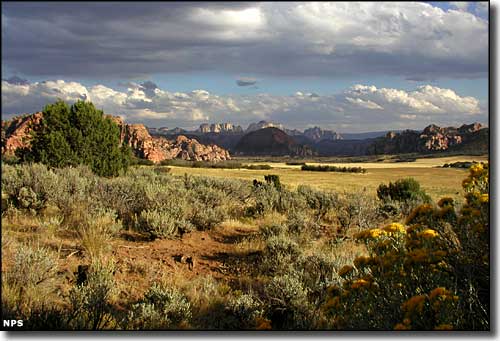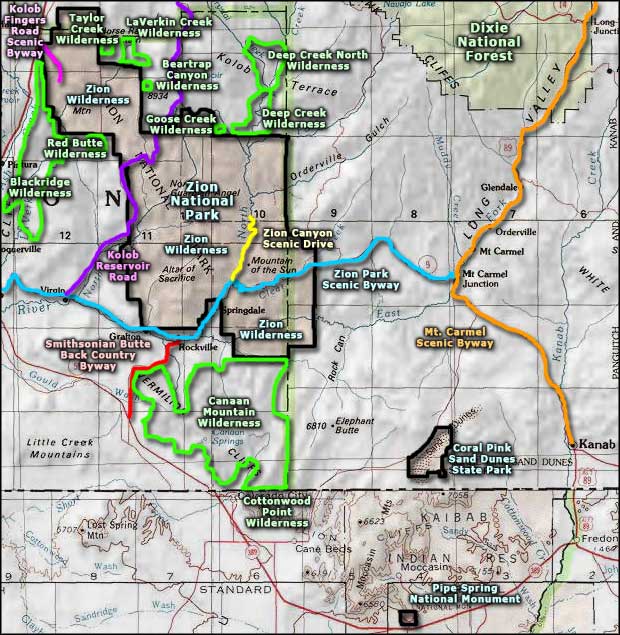
Zion National Park

The view from Zion Canyon Overlook

People used to tell stories about Zion National Park, unbelievable stories: Vividly colored cliffs rising 2,000 and 3,000 feet almost straight up, huge multi-colored monoliths, an extremely rugged countryside filled with very narrow canyons and sculptured landforms... Zion is different from almost anything you'll see anywhere else. What is preserved in Zion National Park, though, is only the heart of the story: nearby are similar geological constructions like Canaan Mountain, Smithsonian Butte and the landscapes of the Red Butte and Blackridge Wildernesses. Just because you cross the park boundary doesn't mean the countryside changes much.
This is truly ancient landscape. Zion Canyon was carved almost "singlehandedly" by the Virgin River, starting about 13 million years ago. The Kolob Canyons that cut into Kolob Terrace were carved by snowmelt running in the Left and Right Forks of North Creek for almost as long. And the colors of the rock run the gamut from light pastels to deep reds and almost burgundies.
There are deep slot canyons here so narrow that two people cannot pass each other in the walkway. There are waterfalls and lush hanging gardens, hoodoos and immense sandstone arches, paved accessible trails and ridgetop trails where you'll be hanging on to the provided chains... This is a place you don't want to miss, but you don't want to be in a hurry either.
In 2009, Congress designated some 124,406 acres of Zion National Park as Zion Wilderness (and that's the vast majority of the park). Around the park are a couple hundred thousand acres of BLM wilderness, too. The park offers multiple short day hikes in addition to many longer back country hikes.
Camping in the back country is allowed but only in designated sites, some of which are reservable but most are walk-up (first come, first served). Most services and information are available at the Zion Canyon Visitor Center which is open every day of the year except Christmas. Summer hours are from 8 am to 8 pm daily but most of the rest of the year, hours are 8 am to 5 pm. The Kolob Canyon Visitor Center is also open year round, except for Christmas Day. Spring and summer hours: 8 am to 5 pm, the rest of the year: 8 am to 4:30 pm.
Entry fees: Private passenger vehicles: $25 for up to 14 passengers, good for seven days from date of purchase. Motorcycle: $12, good for seven days. Pedestrians, bicyclists, hikers: $12, good for seven days.

Zion National Park offers three campgrounds. South and Watchman Campgrounds are in the southern park of the park in Zion Canyon. The Lava Point Campground is on the Kolob Terrace Road (also known as Kolob Reservoir Road). There are no campgrounds in the Kolob Canyons area. Most of the year sees the campgrounds full early in the day so you might want to try to make reservations in advance. Lava Point Campground is open from June through October and offers only six primitive campsites with pit toilets and garbage collection but no water. The campground access road off Kolob Terrace Road doesn't accommodate vehicles longer than 19 feet... but the camping is free if you can get there.
From early April to late October, private vehicles are not allowed to drive the Zion Canyon Scenic Drive. Visitors to that part of the park need to ride the Zion Canyon Shuttle. The Zion Canyon Shuttle also runs regular routes through Springdale at that time of year. Transfer point between the two shuttles is at the Zion National Park Visitor Center. The shuttles are universally accessible and the ride is free. Bicycles are allowed on the route and visitors staying at Zion Lodge are, too, as long as they have the red permit prominently displayed in their windshield (and they need the permit to park at the Lodge parking garage).

Angels Landing

Zion National Park Visitor Center

Kolob Terrace

Zion National Park area map
